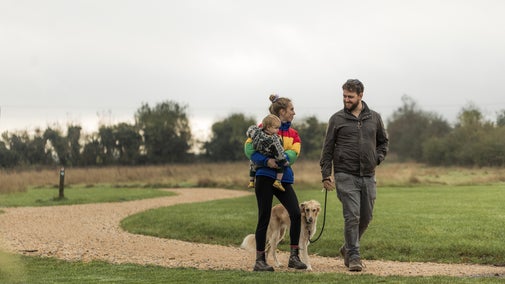Rodborough Common butterfly walk
Gloucestershire & the Cotswolds
Follow this trail through natural grassy tracks and hillsides to Swellshill for the opportunity to spot more than 30 species of butterfly. The steep grassland slopes of Rodborough Common create the perfect habitat for the Adonis blue and Duke of Burgundy butterflies, as well as many other species. Look out for rare wild flowers and enjoy far-reaching views over the Severn Estuary on the route.
Start point
National Trust car park, grid reference: SO850035Trail information
*Grassy tracks, hillsides and a quiet tarmac lane. For further details, please see Terrain section.
**Use alternative quiet lane between points 2 and 3 for pushchairs and wheelchairs. For further details, please see section marked Access.
***Grazing livestock so please keep your dog on a short lead and under close control. For further details, please see section marked Facilities.
Butterfly species
Rodborough Common is one of the best places in the UK to see the Duke of Burgundy butterfly. The Adonis blue butterfly has also returned after an absence of 40 years, and feeds on the great variety of wild flowers here. Other species to spot include the green hairstreak, dingy skipper, marbled white, small blue and chalkhill blue. There are more details on when to see the butterflies within each step.
More near here
Rodborough woodlands walk
Discover some of Rodborough Common's hidden treasures on this walk exploring the woodlands on the lower slopes, visiting Cotswold villages along the way.

Rodborough Common views walk
If you're pushed for time, you can still enjoy some of the best views the Cotswolds has to offer on this short walk.

Rodborough Fort walk
An easy 1-mile walk around Rodborough Fort, taking in the unique flora and fauna of the limestone grassland.

Get in touch
Our partners

We’ve partnered with Cotswold Outdoor to help everyone make the most of their time outdoors in the places we care for.
You might also be interested in
Walking in Gloucestershire and the Cotswolds
From a long-distance hike on the Cotswold Trail to a stroll through a secluded valley at Woodchester Park, these are some of the best walks in Gloucestershire and the Cotswolds.

Explore the countryside at Minchinhampton and Rodborough Commons
Home to rare and diverse wildlife and wildflowers, Minchinhampton and Rodborough Commons are perfect for a discovering nature in all shapes and sizes.

Visiting Minchinhampton and Rodborough Common with your dog
Minchinhampton and Rodborough Commons are a great place to explore your dog, with wide expanses to explore and views for miles.

Top tips for butterfly spotting
Discover how to spot butterflies without scaring them away, and find out which types of plants will attract them to your garden or green space.

Walking
Explore some of the finest landscapes in our care on coastal paths, accessible trails, woodland walks and everything in between. Find the best places to walk near you.

Follow the Countryside Code
Help to look after National Trust places by observing a few simple guidelines during your visit and following the Countryside Code.

Cotswold Outdoor: our exclusive walking partner
Learn about the National Trust’s ongoing partnership with Cotswold Outdoor. Find out how they help us care for precious places and the exclusive discount available for National Trust supporters.

Staying safe at National Trust places
The special places in National Trust care sometimes come with a few risks for visitors, be it coastline or countryside. Find out how to keep safe throughout your visits.



